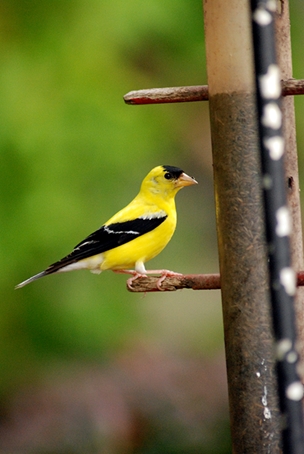Feathered color is returning to the northen garden...

enlarge this imageHave no birds, want them? Put out a feeder. Have a feeder? Put out another kind since some bids prefer to perch, others to sit on a platform, some prefer sunflower, others thistle. Some such as juncos like to forage on the ground so it's also helpful to stamp down the snow around a feeder. Almost as important, keep clean water in a shallow bird bath. (Yes, especially now when it's cold; fill a plastic birdbath daily and the birds will find it each day before it freezes!)
Birds are back, stretching their wings and coloring up!
Probably you've noticed that the rumpus has begun. We laugh and
call the early morning racket at our window the cocktail party, as
two- and three times as many birds tune up each morning in response
to March's longer days, while migrants set up camp to announce
their presence and reclaim territory. It's sounds cheery and also
looks wonderful -- a real smile maker.
Or maybe you have less of this activity. If your yard is quiet,
now is the time to do all you can to bring the birds to your yard.
A feeder and some seed are very important in
winter and early spring!

Study on it?
Kids sure do know a lot about
birds!
Read what our
Kid's View reporters have to say.
You can download our class notes from Gardening for
Wildlife, which outline the basic formula for attracting all
wildlife and explore the variable details for butterflies,
dragonflies, amphibians, songbirds, specific birds including
hummingbirds, etc. The package includes six pages of plant lists
including a butterfly larval host plant chart (caterpillar plants).
Plant lists include basic growing information and specific
animals/birds attracted.
download the pdf of class notes plus plant lists
download only the plant
lists including perennials, annuals, shrubs, trees and
caterpillar host plants.



To have lots of butterflies in the garden all spring and
summer, the most important thing you can do is supply the plants
each caterpillar needs to eat. Most butterflies will lay
eggs only on a few particular plants -- what the monarch
caterpillar eats, the yellow swallowtail cannot, and the
blue-spotted purple can't swap places with the caterpillar of the
yellow sulfur. So the Host Plant List in our wildlife class is a
helpful tool.
